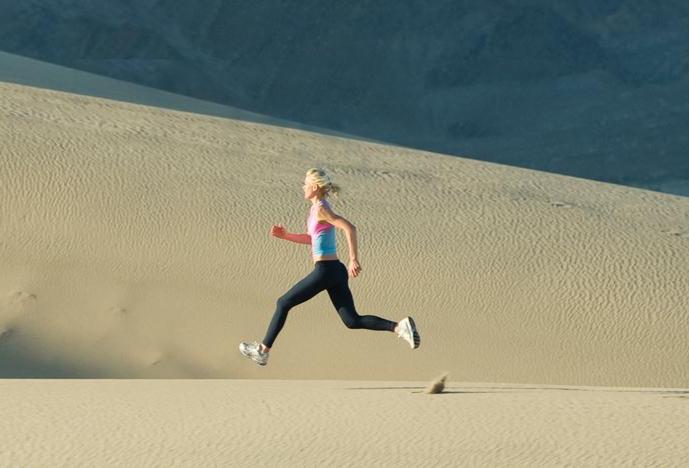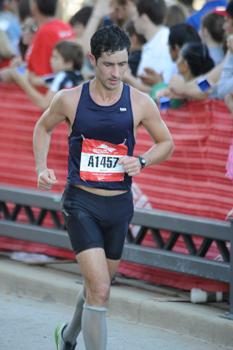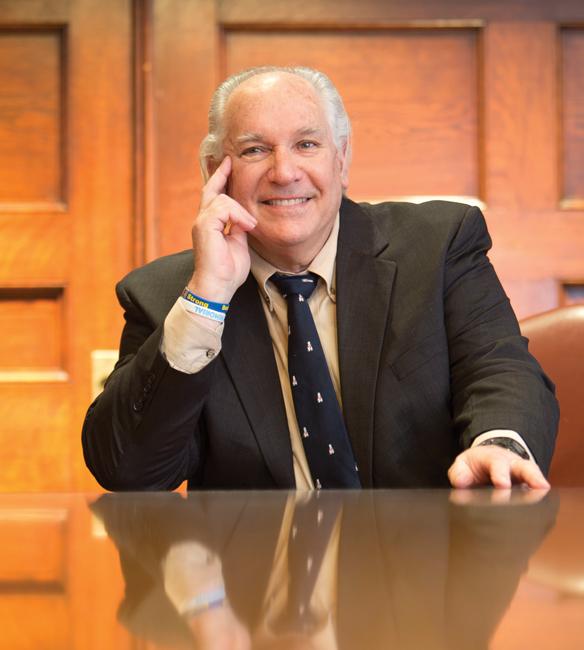Enduring Pleasures
What happens when athletes push themselves to their physical limits?
- Feature

Aaron Baggish passes a grapefruit-sized wooden ball from hand to hand. Hewn from pine, the sphere wears hundreds of almond-shaped gouges on its honey-colored surface.
This type of bolais used by the Tarahumara people—“those with nimble feet.” They kick it over rocky trails in the rugged Copper Canyon region of northern Mexico as part of a centuries-old festival called Rarájipari. They run as teams from early morning through the night and into the next morning, all the while moving the ball forward with their feet. It is a ritual we would call an endurance contest. They call it a game of life.
They don’t run very fast; they just run for long periods,” Baggish says. “The turning of the ball represents the turning of the world, and moving the ball as a team symbolizes interacting with a turning world in a healthy way.”

Baggish, an HMS assistant professor of medicine and a cardiologist at Massachusetts General Hospital, visited the Tarahumara people with his running partner Daniel Lieberman, the Edwin M. Lerner II Professor of Biological Sciences at Harvard, who is an evolutionary biologist and a researcher who explores the effects of running barefoot. Baggish brought more than the bola back to Boston. The day before the Rarájipari, he secured ultrasound images of the hearts of the best runners so he could compare them to like scans of indigenous people who had moved into towns and, unlike the Tarahumara, left their running habits behind.
Judging by those scans, Baggish says, the hearts of the runners were large, just like the hearts of Olympians and other supremely gifted athletes who are devoted to regimens that help them deliver first-rate performances. Yet when Baggish asked the Tarahumara runners about training, he learned that the concept was foreign to them. So was the concept of exercise. They run to get someplace faster than if they were to walk. A couple of times a year, they run day and night in long competitions that are celebrations meant to set the world in balance.
Outside the Copper Canyon, endurance events may seem designed to pluck at extremes rather than embrace balance. Ambulances trailed the first band of 15 Boston marathoners in 1897; there was a fear that the runners would not survive their run through the winding roads of Eastern Massachusetts. More than a hundred years later, the competitive challenges taken on by endurance athletes still inspire a healthy dose of skepticism. The sports these athletes participate in include not only running but also rowing, cross-country skiing, cycling, and swimming; in short, any continuous physical activity guaranteed to demand maximal oxygen intake by the athlete.
Physicians and scientists like Baggish are building a body of research to illuminate what happens when we push the limits of our physical selves. He studies, for example, young athletes on the cusp of rigorous training that may sculpt their hearts for a lifetime. Baggish also screens young people to determine whether they carry a congenital, often undetected, flaw that could, in the throes of intense athletic effort, set them on a path toward sudden cardiac arrest. And he helps older athletes with high blood pressure or elevated cholesterol levels adjust their medications—and their expectations—so they can stay active in the sports they passionately pursue.
“There’s this myth that everything about exercise is good for you,” Baggish says. “You’re not going to find a cardiologist anywhere who advocates for exercise more than I do. But on the high ends of both strength and endurance exercise, there may be a price to pay down the line.”
Alternative Energy
How much is too much of a good thing? According to many researchers, we really don’t know. Exercise physiology is a young discipline, Howard Knuttgen reminds us, getting its start in North America in the 1950s, perhaps half a century behind its advent in Europe. Knuttgen, an HMS research associate in physical medicine and rehabilitation at Spaulding Rehabilitation Hospital, points out that enshrining exercise as part of a healthy lifestyle is a relatively recent development.
“In the late 1940s, when I was in college,” he says, “there was no evidence that physical activity had any effect on longevity. There were many physicians who pooh-poohed the need for exercise.”
A researcher trained in exercise and muscle physiology in both Denmark and the United States, Knuttgen has served for more than two decades as the coordinator of scientific publications for the Medical Commission of the International Olympic Committee. Throughout those years, he says, instrumentation that can measure biochemical and physiological changes improved significantly, allowing advances in our understanding of how the human body performs athletic feats.
Although strength and endurance in sports are often considered synonymous, from a biophysical perspective they are poles apart, starting with the fuel that powers a single movement or thousands of repeated movements. Imagine a weightlifter, for example, marshaling her muscles for a hoist of the heaviest set of weights in the gym. The exertion requires her muscle cells to tap the high energy packaged in the compound adenosine triphosphate, better known as ATP, for the fuel needed for an intense burst of power. Such an energy expenditure allows one, perhaps two, such movements before exhaustion.

Contrast her effort to that of a long-distance runner, who may hammer out twenty thousand steps to complete a marathon. His muscle cells require a measured output of power: the aerobic metabolism of carbohydrates and fats. Drawing upon this resource supplies the muscles with a flow of energy that’s less intense but longer lasting. Exhaustion occurs, but after a prolonged period of exertion.
Sports conditioning increases the body’s number of capillaries to help ferry oxygen to muscles. Aerobic conditioning also improves the metabolic capacities of some muscle cells to use oxygen to convert carbohydrates or fats into energy. Distance athletes further amp up their maximum oxygen capacity by performing high-intensity speed workouts on days opposite their longer, slower training sessions.
Feel the Burn
Endurance sports training sets up a cycle of tissue injury and repair that helps improve conditioning and performance over time. Exercise is a form of stress recognized by all of the body’s systems. Some degree of very mild injury comes with that stress, followed by beneficial repair. Over time, consistently injuring and repairing tissues develops a strengthened response.
Arthur Siegel ’67, an HMS associate professor of medicine and chief of internal medicine at McLean Hospital, worries about the inflammation that muscle injury can ignite during races that are typically longer and more intensive than any training run. He has grave concerns about the health of some distance runners when they are two-thirds of the way through a marathon. For Boston runners, that point is known as Heartbreak Hill, the dreaded stretch in Newton where competitors can fade.
By the time they hit that two-thirds mark, runners have spent their carbohydrate stores and are running on fumes. Among runners, it’s known as hitting the wall; for Siegel it portends a different kind of crash: heart attack. Blood samples taken from healthy marathon runners after they crossed the finish line gave values that showed anything but health: The blood samples revealed signs of inflammation similar to those found in patients with heart disease. Among the runners, however, the signs of inflammation subsided within a day.
That transient inflammation, Siegel says, is the result of stress that occurs when muscle injury starts an inflammatory cascade that also thickens the blood, which may then clump, blocking arteries and starving the heart of oxygen.
Heart, Shaped
In 2006, Baggish launched the Harvard Athlete Initiative to gather research on two groups of athletes: football players and rowers. Football players are strength athletes who use explosive bursts of power to charge down the field, tackle an opponent, or ready themselves for a collision with a rival bent on doing the same. Rowers are endurance athletes, pulling their oars and pushing their legs in a rhythm that sends slender boats slicing through the water.
The athletes look different—muscular linebackers can be as large as bodybuilders, while rowers tend to be as lean as their shells. Their hearts look markedly different, too. In endurance athletes, imaging reveals thin, supple walls surrounding the chambers of the heart. The chambers themselves enlarge over time so they can pump the amount of blood needed to meet the muscles’ demand for oxygen; the heart’s rate doesn’t increase, but the volume of blood it can circulate does.
For strength athletes, imaging shows that the walls of their hearts’ chambers are thick. One thing that concerns Baggish is the stiffness of those thick walls, which resembles that found in the heart chambers of middle-aged men with high blood pressure.
For endurance athletes such as runners, the overall incidence of cardiac arrest during or directly after a marathon is very low, according to an analysis of a decade’s worth of data that Baggish published in 2012 in the New England Journal of Medicine. Distance matters, however, as does gender. The incidence was significantly higher among participants in marathons compared with those running half marathons and among men compared with women.
In the Long Run
“When you run a marathon, you are crossing the Rubicon,” Siegel says. “You’re going into a state of muscle injury.”
His solution? Aspirin. He recommends that runners, especially men over age 45, take a small dose just before a race. Siegel is the first to say, however, that among physicians his is a minority opinion. But the medical director of the 2014 Rio de Janeiro Marathon includes a recommendation that male athletes over 40 take a low-dose aspirin if authorized by their physician.

Baggish and Siegel both urge more research on athletes. Baggish is accruing evidence through the work of the Harvard Athlete Initiative, believing that an ideal time to study the lasting effects of exercise is not after Olympic athletes climb the podium, but before freshmen begin their college sports careers, while their bodies are still being molded. In addition, he hopes to describe the physiological effects of exercise in the nonathlete. Such insight would be useful; in the clinic, says Baggish, physicians still don’t know how much movement to prescribe.
Baggish will be again turning to the Tarahumara runners to compare their long, steady, slow running to the competitive athlete’s mix of high speed and hard distance.
“I think we’re going to learn that duration and intensity provide two very different signals,” he says.
Finding a balance between these signals may answer at last how far and how hard we should push ourselves.
Elizabeth Cooney is a science writer in the HMS Office of Communications and External Relations.
Images: Mattias Paludi (top); Courtesy of Aaron Baggish; John Soares (Knuttgen and Seigel)